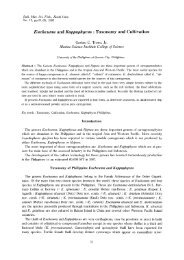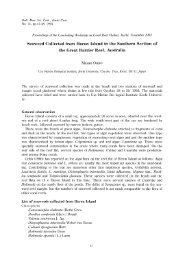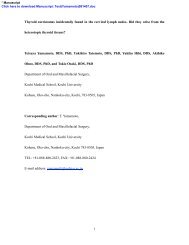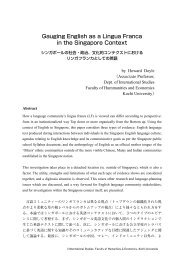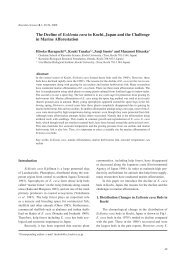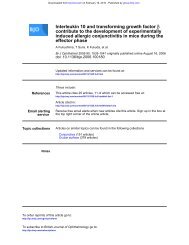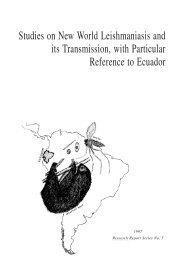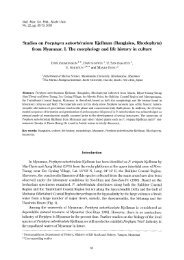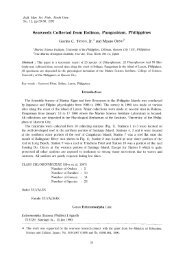Changes in soil bacterial community profiles associated with ...
Changes in soil bacterial community profiles associated with ...
Changes in soil bacterial community profiles associated with ...
You also want an ePaper? Increase the reach of your titles
YUMPU automatically turns print PDFs into web optimized ePapers that Google loves.
Soil <strong>bacterial</strong> communities reflect<strong>in</strong>g land degradation491997) and microbial molecular distribution pattern (Borneman & Triperett, 1997). In these cases, the relationships betweenthe altered <strong>soil</strong> environmental factors and the changes <strong>in</strong> <strong>soil</strong> microbial <strong>profiles</strong> are complicated.It has been recognized that particular environmental changes alter the multivariate <strong>profiles</strong> of <strong>soil</strong> microbialcommunities. Some <strong>soil</strong> environmental changes <strong>in</strong>volved <strong>in</strong> deforestation and <strong>soil</strong> degradation are thought to stress liv<strong>in</strong>gth<strong>in</strong>gs (Giuffre et al. 2001; Sakurai et al. 1998). In the SERS, the drier condition <strong>in</strong> the BG <strong>soil</strong> was suggested to be the mostsignificant factor reduc<strong>in</strong>g number of <strong>bacterial</strong> cells (Table 1) and diversity of the <strong>soil</strong> <strong>bacterial</strong> <strong>community</strong> (Doi & Sakurai2003). The drier <strong>soil</strong> condition <strong>in</strong> the BG <strong>soil</strong> may make it hard for some <strong>soil</strong> bacteria to survive, while may not effect others(Kilbertus & Proth 1979). The difference <strong>in</strong> <strong>soil</strong> moisture content was likely to be the ma<strong>in</strong> <strong>soil</strong> environmental factordifferentiat<strong>in</strong>g the <strong>profiles</strong> (Fig. 5, Doi & Sakurai 2003).A selective force was perhaps a source of variation <strong>in</strong> the <strong>soil</strong> <strong>bacterial</strong> <strong>community</strong> profile <strong>in</strong> the SERS. The low numberof <strong>soil</strong> <strong>bacterial</strong> cells <strong>in</strong> the BG <strong>soil</strong> (Table 1) suggests the importance of a selective force. Another possibly important factoris the change <strong>in</strong>side of <strong>bacterial</strong> cells <strong>in</strong> response to environmental changes. Some environmental changes have been shownto alter <strong>bacterial</strong> phenotypes such as culturability (Arana et al. 1992) and antibiotic resistance (McInroy et al., 1996) andgenotypes such as carbon source utilization (Velkov, 1999) and antibiotic resistance (Pote et al. 2003). These possibly relatedmechanisms need to be <strong>in</strong>vestigated.Land degradation has various aspects (Mausbach & Seybold, 1998). It is thought to be worth analyz<strong>in</strong>g these differentaspects <strong>with</strong> a multivariate strategy (Sena et al., 2000). The aspects <strong>in</strong>vestigated <strong>in</strong> this research are thought to reflect<strong>in</strong>dependently <strong>in</strong>volved events <strong>in</strong> the degradation (Fig. 5). The resistance of bacteria to particular antibiotics was shown tohave l<strong>in</strong>kages to the possible environmental stresses <strong>in</strong> the BG <strong>soil</strong> such as acidity (Ramos et al. 1987) or high temperature(Pillai and Pepper, 1991). A difference <strong>in</strong> above ground vegetation resulted <strong>in</strong> a variation of sole carbon source utilizationpatterns revealed by characteriz<strong>in</strong>g the <strong>soil</strong> <strong>bacterial</strong> isolates (Westover et al., 1998). The sole carbon source utilizationprofile of <strong>bacterial</strong> isolates may be altered when the cell encounters particular environmental stresses (Velkov, 1999). Suchl<strong>in</strong>kages between environmental factors and cells are thought to occur <strong>in</strong>dependently <strong>in</strong> the degradation.The Biolog method profiled the <strong>bacterial</strong> communities based on the sole carbon source utilization patterns (Zak et al.,1994), while methods 1 and 2 measured the patterns of antibiotic resistance and susceptibility, respectively. Differentprofiled aspects have implied the multidimensionality of <strong>soil</strong> discrim<strong>in</strong>ation (Insam & Rangger, 1997). The discrim<strong>in</strong>ationpatterns shown <strong>in</strong> the PC score plots differed among the methods and the Biolog color development stages (Fig. 4),suggest<strong>in</strong>g multidimensionality. By reveal<strong>in</strong>g different ord<strong>in</strong>ation planes, Fig. 5 shows differences among the aspects <strong>in</strong>relation to the <strong>bacterial</strong> <strong>profiles</strong> and the environmental factors. RDA <strong>in</strong>tegrates environmental and biotic data sets, and then,directly relates the biotic <strong>profiles</strong> to the environmental factors. The computation found significant environmental factorsbased on variation of plant (e.g., Bubier, 1995; Hutto et al., 1999; Lyon & Sagers, 2002; Stohlgren & Bachand, 1997; Wali,1999) and other communities (e.g., Bird et al., 2000; Hemerik & Brassaard, 2002; van den Br<strong>in</strong>k et al., 1996) that reflectedvarious environmental changes.On the other hand, few <strong>soil</strong> microbial <strong>community</strong> <strong>profiles</strong> have been analyzed for this purpose (Bossio & Scow, 1995;Pankhurst et al., 2001). Soil microbial <strong>community</strong> profil<strong>in</strong>g may be less labor <strong>in</strong>tensive than plant species survey<strong>in</strong>g. Withrespect to conservation, rehabilitation or agricultural production, <strong>community</strong> profile analysis may suggest a favorablemanagement practice <strong>in</strong> the ord<strong>in</strong>ation diagram (Pankhurst et al., 2001). Furthermore, given pieces of <strong>in</strong>formation may differamong communities <strong>in</strong> the same space as shown by Hermerik & Brussaard (2002). Thus, profil<strong>in</strong>g <strong>soil</strong> microbialcommunities is another <strong>in</strong>formative alternative.The empirical approach adopted by Bossio & Scow (1995) could be powered by <strong>in</strong>vestigat<strong>in</strong>g possible cause and effectrelationships as po<strong>in</strong>ted out by Kourtev et al. (1998). Any of the significant <strong>soil</strong> environmental factors <strong>in</strong>dicated <strong>in</strong> Fig. 5 maybe the cause of the poor productivity of the BG <strong>soil</strong>, while the environmental changes summarized <strong>in</strong> Table 1 are results ofdeforestation. The altered Biolog profile of the BG <strong>soil</strong> likely reflected altered <strong>soil</strong> <strong>bacterial</strong> functions (Zak et al. 1994).Benefical <strong>soil</strong> bacteria are known to contribute to plant growth through m<strong>in</strong>eral solubilization (Derylo & Skorupska, 1992),nitrogen fixation (Albrecht et al. 1981), plant growth hormone production (Neitko & Frankenberg, 1989) and plant pathogensuppression (Handman et al. 1991). Investigat<strong>in</strong>g relationships among environmental changes, plant growth and the benefical<strong>soil</strong> <strong>bacterial</strong> functions will help us develop methods to rehabilitate degraded <strong>soil</strong>s.As described <strong>in</strong> a previous report (Doi & Sakurai, 2003), <strong>soil</strong> moisture content was thought to be the most decisiveenvironmental factor on the variation <strong>in</strong> <strong>soil</strong> <strong>bacterial</strong> <strong>community</strong> <strong>profiles</strong> (Fig. 5). Other <strong>soil</strong> environmental changes <strong>in</strong>volved<strong>in</strong> the degradation were also the possible causes and/or the effects of the changes <strong>in</strong> <strong>soil</strong> <strong>bacterial</strong> <strong>community</strong> <strong>profiles</strong>. The



